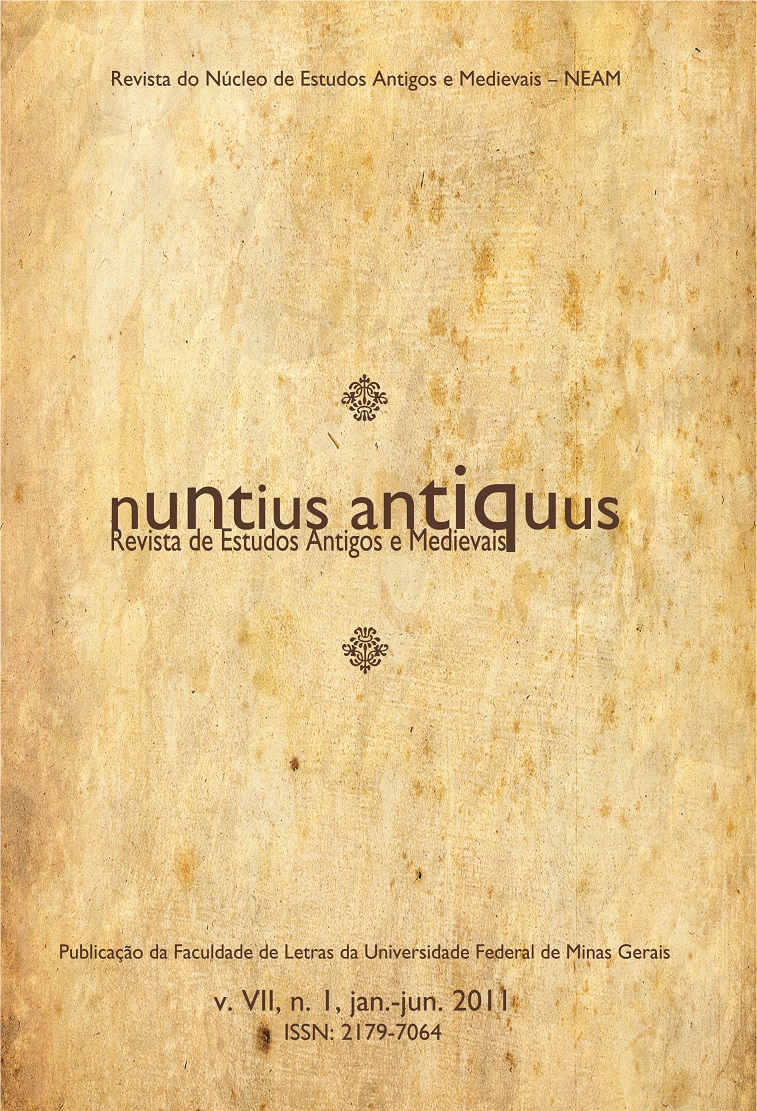Tramas de Afrodite e Eros: sedução e capitulação na mélica grega arcaica
DOI:
https://doi.org/10.17851/1983-3636.7.1.60-78Palavras-chave:
eroticism, archaic Greek melic poetry, Aphrodite, ErosResumo
This article presents a study of Aphrodite’s and Eros’s images in archaic Greek melic poetry, in some fragments where the “I”, as a result of their divine action, becomes a helpless victim of the power of erotic desire and/or a seducer/seductress in pursuit of the beloved one. These are the melic poets and fragments herein commented: Alcman (Fr. 59(a) Dav.), Sappho (Frs. 1, 102 Voigt), Ibycus (Frs. 286, 288, 287 Dav.).
Referências
BONELLI, G. Lettura estetica dei lirici greci. RSC. v. XXV, p. 65-94, 1977.
BOWRA, C. M. Greek lyric poetry. Oxford: Clarendon Press, 1961.
BREMER, J. M. Greek hymns. In: VERSNEL, H. S. (Org.). Faith, hope and worship. Leiden: Brill, 1981. p. 193-215.
BRILLANTE, C. L’inquietante belleza di Eurialo. RCCM. v. XL, p. 13-20, 1998.
CALAME, C. The poetics of eros in ancient Greece. Translated by J. Lloyd. Princeton: University Press, 1999.
CAMPBELL, D. A. Greek lyric poetry. London: Bristol, 1998.
CARSON, A. The justice of Aphrodite in Sappho 1. In: GREENE, E. (Org.). Reading Sappho. Berkeley: University of California Press, 1996. p. 226-232.
CARSON, A. Eros, the bittersweet. Chicago: Dalkey Archive Press, 1998.
CAVALLINI, E. Ibico. Introdução, tradução e comentário de E. Cavallini. Lecce: Argo, 1997.
CHANTRAINE, P. Dictionnaire étymologique de la langue grecque. Paris: Klincksieck, 1999.
DAVIES, M. Symbolism and imagery in the poetry of Ibycus. Hermes. v. CXIV, p. 399-405, 1986.
DUMONT, J. Les animaux dans l’Antiquité grecque. Paris: L’Harmattan, 2001.
EUTERPE. Comentário de D. E. Gerber. Amsterdam: Adolf M. Hakkert, 1970.
FALKNER, T. M. The poetics of old age in Greek epic, lyric, and tragedy. Norman: University of Oklahoma Press, 1995.
FINLEY, M. I. Introduction. In: FALKNER, T. M.; de LUCE, J. (Org.). Old age in Greek and Latin literature. Albany: State University of New York Press, 1989. p. 1-20.
GARRISON, D. H. Sexual culture in ancient Greece. Norman: The University of Oklahoma Press, 2000.
GENTILI, B. Metodi di lettura (su alcune congetture ai poeti lirici). QUCC. v. IV, p. 177-181, 1967.
GREEK MELIC POETS. Introdução, edição e comentário de H. W. Smith. New York: Biblo and Tannen, 1963.
HESÍODO. Os trabalhos e os dias. Trad. C. N. Lafer. São Paulo: Iluminuras, 2002.
HESÍODO. Teogonia. A origem dos deuses. Tradução e estudo de Jaa Torrano. São Paulo: Iluminuras, 2003.
HESÍODO. Theogony. Edited by M. L. West. Oxford: Clarendon Press, 1988.
HESÍODO. Works and days. Edited by M. L. West. Oxford: Clarendon Press, 1982.
IRWIN, E. The crocus and the rose. In: GERBER, D. E. (Org.). Greek poetry and philosophy. Chicago: Scholars Press, 1984. p. 147-168.
LAFER, M. de C. N. Introd., trad., notas. Hesíodo. Os trabalhos e os dias. 4. ed. São Paulo: Iluminuras, 2002.
L’antica lirica greca. Commento di A. Colonna. Torino: S. Lattes, 1963.
LARDINOIS, A. Who sang Sappho’s songs? In: GREENE, E. (Org.). Reading Sappho. Berkeley: University of California Press, 1996. p. 150-172.
LASSERRE, F. La figure d’Eros dans la poésie grecque. Lausanne: Imprimiers Réunies, 1946. LESKY, A. História da literatura grega. Trad. M. Losa. Lisboa: Calouste Gulbenkian, 1995.
LYONS, D. Dangerous gifts. ClAnt. v. XXII, p. 93-135, 2003.
MACLACHLAN, B. Personal poetry. In: GERBER, D. E. (Org.). A companion to the Greek lyric poets. Leiden: Brill, 1997. p. 133-220.
MOTTE, A. Prairies et jardins de la Grèce antique. Bruxelles: Academie Royale de la Belgique, 1973.
PARRY, H. Thelxis. Lanham: University Press of America, 1992.
PIRENNE-DELFORGE, V. L’Aphrodite grecque. Athènes: Cierga, 1994.
POETARUM MELICORUM GRAECORUM FRAGMENTA. Edidit M. Davies. Oxford: Clarendon Press, 1991.
POLINNIA: POESIA GRECA ARCAICA. Comentário, introdução e traduções de G. Perrotta, B. Gentili e C. Catenacci. Messina: Casa Editrice G. D’Anna, 2007.
PRIVITERA, G. A. La rete di Afrodite. Palermo: Aracne, 1974.
RACE, W. H. Aspects of rhetoric and form in Greek hymns. GRBS. v. XXIII, 1982, p. 5-14.
RAGUSA, G. Fragmentos de uma deusa. A representação de Afrodite na lírica de Safo. Campinas: UNICAMP, 2005. (Apoio: Fapesp)
RAGUSA, G. Lira, mito e erotismo. Afrodite na poesia mélica grega arcaica. Campinas: UNICAMP, 2010. (Apoio: Fapesp)
ROBBINS, E. Public poetry. In: GERBER, D. E. (Org.). A companion to the Greek lyric poets. Leiden: Brill, 1997. p. 221-288.
SKINNER, M. B. Woman and language in archaic Greece, or, why is Sappho a woman? In: GREENE, E. (Org.). Reading Sappho. Berkeley: University of California Press, 1996, p. 175-192.
TORTORELLI, W. A proposed colometry of Ibycus 286. CPh. v. XCIX, p. 370376, 2004.
TSAGARAKIS, O. Broken hearts and the social circumstances in Sappho’s poetry. RhM, v. CXXIX, p. 1-17, 1986.
VOIGT, E.-M. (Org.). Sappho et Alcaeus. Amsterdam: Athenaeum/ Polak & Van Gennep, 1971.










